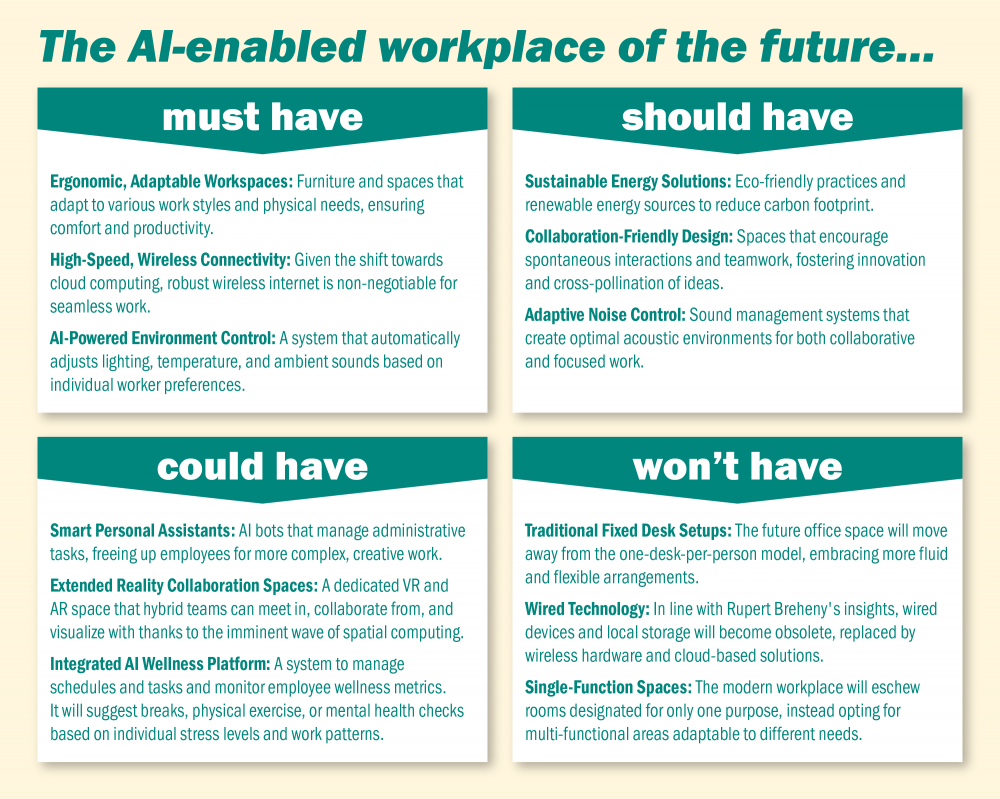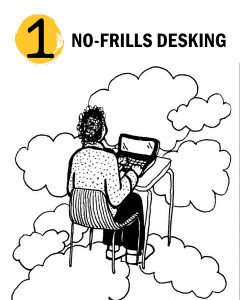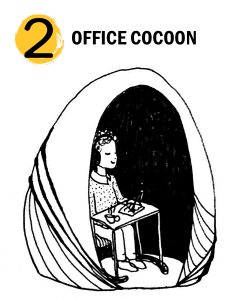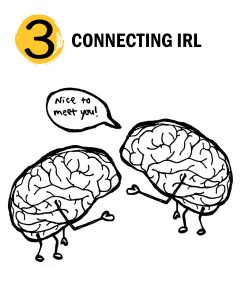Perkins Eastman interviews AI expert Rupert Breheny on prioritizing ‘uniquely human’ skills, designing for change, and why we will ‘look back on wired things with absolute horror’.
If you were blindfolded and dropped into a 1950s-era office, we’re willing to bet you’d know right away that you weren’t in Kansas anymore. The click-clacking typewriters, whirring rotary phones, rustling papers, and rumbling cabinet drawers would give it away even before you smelled the ash trays and saw the neatly-dressed typists transcribing memos and filing paperwork.
Digital technology has changed the office in just about every conceivable way. The personal computer replaced a constellation of supplies and equipment that were once essential to getting work done. With bulky equipment like typewriters, ledger books, manual tabulation machines, and paper stacks out of the way, desks and file cabinets could shrink to the size of a Central Processing Unit. Today’s office looks different, but that isn’t the only change.
Beyond the desk, the personal computer transformed office culture. It changed communication, work-life balance, and even physical health (Zomorodi, 2023). Eliminating certain routine tasks freed workers to focus on strategic thinking and problem-solving. Automation drove a fundamental shift in staffing and operations, boosting demand for different kinds of roles and skill sets. The advent of personal electronic devices, like laptops and Blackberries, enabled work to happen from anywhere and, in doing so, shifted the boundary between work and personal life.

We are on the cusp of another quantum leap, according to AI expert Rupert Breheny.
A new technology has evolved to the point where it can be used by ordinary people, in multiple applications, from home to workplace and many places in between.
This month, Perkins Eastman sat down with Rupert, who has worked for Google and the BBC, amongst many other organizations to understand the role of AI in office life and how workplace designers can prepare for the sea change that is coming. Here are three key moments from the interview.
Perkins Eastman: Imagining an AI-adapted future, what does a day in the office look like?
Rupert Breheny: In the future, imagine walking around in an invisible bubble that represents you and your preferences. When you’re in the office, you never have to touch a light switch, a thermostat, a video meeting panel, or a door handle. Maybe your scheduled meeting room pre-heats or cools to just the right temperature. As you approach your workstation, the lighting dims and perhaps plays localized ambient audio of your choice. When a workmate stops by your desk, the audio stops and the lights brighten. Your environment recognizes you, it can anticipate your needs, and it wants to make you comfortable. We are already in the domain of science fiction, so I believe this is really not far off on the horizon.
Perkins Eastman: What is the role of the office in this future reality?
Rupert Breheny: Those so-called ‘spontaneous encounters’ at the coffee machine really can lead to cross-pollination, which is key for innovation. But it will also be important to have a work environment that puts you in the right headspace to do creative work. Cozy, cocoon-like spaces, shielded from distractions, where you can put your head down on creative problems or tasks that require more focus. The office needs to support in-person, human connection as much as it supports opportunities to disengage and recharge.
Check out WDM’s Private Work Pod Roundup: Empowering Neurodiversity in the Workplace
Perkins Eastman: Technology changes so quickly—today’s ‘it’ tech tool could be out of the picture tomorrow. How can workplace design keep up?
Rupert Breheny: It’s not as much about keeping up as, I think, maximizing adaptability. The tool itself is almost irrelevant because soon, everything will happen in the cloud. Your primary device might be as small as an iPhone, so all you’ll really need is a comfortable place to sit. The essential thing is wireless connectivity. We’re going to look back at wired things with absolute horror!
Three Key Takeaways
 The ideal workstation doesn’t need bells and whistles. A spacious desk with a monitor that accepts wireless video and streaming may be all that is needed. Soon, the desktop will charge wireless keyboards and the mouse as you use them. Your phone becomes the hub of your entire digital life, and a USB-C connection will let you run full-screen apps on an external monitor.
The ideal workstation doesn’t need bells and whistles. A spacious desk with a monitor that accepts wireless video and streaming may be all that is needed. Soon, the desktop will charge wireless keyboards and the mouse as you use them. Your phone becomes the hub of your entire digital life, and a USB-C connection will let you run full-screen apps on an external monitor.
 People think, learn, and experience the world differently. To accommodate neurodiversity in the workplace, provide a range of settings suited to different tasks and preferences. Cocoon-like spaces, for example, could be designed to support calm and relaxed states conducive to creativity and focus. Modulating light and sound levels, as well as thoughtful material selection, are also part of designing a sensory-aware workplace (Bethold, 2022).
People think, learn, and experience the world differently. To accommodate neurodiversity in the workplace, provide a range of settings suited to different tasks and preferences. Cocoon-like spaces, for example, could be designed to support calm and relaxed states conducive to creativity and focus. Modulating light and sound levels, as well as thoughtful material selection, are also part of designing a sensory-aware workplace (Bethold, 2022).
 Human creativity can be augmented by AI, but not replaced. Creative imagination, drawing connections between seemingly unrelated concepts to come up with new ideas, is a uniquely human skill. And being together—in person, with some frequency—allows working relationships to grow and evolve over time. Embedding the workplace with large and small opportunities to connect in real life can put synergies in motion and help make the most of the time spent in the office.
Human creativity can be augmented by AI, but not replaced. Creative imagination, drawing connections between seemingly unrelated concepts to come up with new ideas, is a uniquely human skill. And being together—in person, with some frequency—allows working relationships to grow and evolve over time. Embedding the workplace with large and small opportunities to connect in real life can put synergies in motion and help make the most of the time spent in the office.
Read more about Rupert Breheny’s work in the January issue of Vogue Business and on his consultancy website at www.cobaltstars.com.
Meet The Perkins Eastman Design Strategy Team:
Katie Gluckselig, Senior Design Strategist
Kristina Koch, Senior Design Strategist
Charlotte Bohning, Design Strategist
Hanna Negami Ph.D, Data Strategist
Jinxian Xu, Design Strategist
Connor Glass is a design director for Perkins Eastman’s workplace practice and member of the international workplace leadership team.
References
Zomorodi, Manoush, Monteleone, Katie, Meshkinpour, Sanaz, Fulkner White, Rachel, (2023, October) NPR “When human met desk: a toxic relationship for the ages” Retrieved from: https://www.npr.org/2023/10/10/1200611619/the-history-of-computer-related-pain-and-how-to-stop-it
IMAGE CREDITS
Hand-drawn illustrations
Charlotte Bohning, Perkins Eastman
MoSCoW graphic
Rupert Breheny, Cobalt founder, and Connor Glass, Perkins Eastman Principal and Workplace Leader.
Vintage office photo
Adobe Stock

